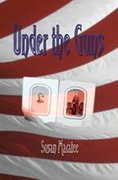Tuesday, December 12, 2006
There are many fallacies about the Irish Famine. One of them is that there was no food to be had in Ireland at this time.
In truth, there was plenty of food in Ireland at the time. Many Irish families existed on little but the potato, mixed with a little milk or buttermilk and a few wild onions. But the other crops they grew, which included corn, rye, wheat, etc., was harvested and given to the landlords to pay the rent on their tiny cottages. Failure to do that resulted in their being evicted and their cottages “tumbled” (the thatch was pulled off and the walls knocked down).
Livestock also thrived during the Irish Famine. Aside from corn and grain, the other major export of Ireland during the Famine was livestock.
In Ireland Before and After the Famine, author Cormac O’Grada documents that in 1845, a famine year in Ireland, 3,251,907 quarters (8 bushels = 1 quarter)) of corn were exported from Ireland to Britain. That same year, 257,257 sheep were exported to Britain. In 1846, another famine year, 480,827 swine, and 186,483 oxen were exported to Britain.
Dr. Christine Kinealy, a fellow at the University of Liverpool and the author of two scholarly texts on the Irish Famine: This Great Calamity and A Death-Dealing Famine, says that 9,992 calves were exported from Ireland to England during "Black'47", an increase of thirty-three percent from the previous year. In the twelve months following the second failure of the potato crop, 4,000 horses and ponies were exported. The export of livestock to Britain (with the exception of pigs) increased during the "famine". The export of bacon and ham increased. In total, over three million live animals were exported from Ireland between 1846-50, more than the number of people who emigrated during the famine years.
In later years, the Great Hunger has been referred to as a” planned starvation,” an attempt by the British government to rid itself of the Irish population.
http://www.nde.state.ne.us/SS/irish/irish_pf.html
http://www.ucc.ie/famine/Ireland's%20Famine/bibliography.htm
http://www.fenians-nky.com/hungerhistory.htm
First Atlantic Wireless Transmission 1901
Guglielmo Marconi, Italian physicist and radio pioneer, succeeded in sending the first radio transmission across the Atlantic Ocean. By doing so, he disproved detractors who believed that the curvature of the earth would limit transmission to 200 miles or less.
His all important record setting message? The Morse Code signal for the letter s. A little disappointing isn’t it. Eh, all in all, still impressive. The message did travel more than 2,000 miles from Poldhu, Cornwall, England, to Newfoundland, Canada.
Paradoxically, Marconi’s detractors were right. Radio waves could not follow the curvature of the earth. As it happened, Marconi's transatlantic radio signal had been headed into space, but reflected off the ionosphere and bounced back down toward Canada.
More experiments were needed, and much about the laws of radio waves and the role of the atmosphere in radio transmissions still remained to be learned. However, Marconi continued to play a leading role in radio discoveries and innovations during the next 30 years.
In 1909, he was jointly awarded the Nobel Prize in physics with the German radio innovator Ferdinand Braun. On the day of his funeral in 1937, all BBC stations were silent for two minutes as a tribute to his contributions to the development of radio.
http://www.history.com/tdih.do?action=tdihArticleCategory&id=7109
http://nobelprize.org/nobel_prizes/physics/laureates/1909/marconi-bio.html
http://www.pbs.org/wgbh/aso/databank/entries/btmarc.html
Monday, December 11, 2006
Pinckney Benton Stewart Pinchback, Governor 1872
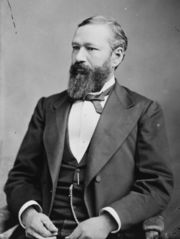
P. B. S. Pinchback was the first African-American to become governor of a U.S. state. Pinchback, a Republican, served as the governor of Louisiana from December 9, 1872, to January 13, 1873. He was sworn in today, 1872
Not a very long term, 27 days, but all things considered, a first is a first. An immutable rule of marketing is ‘it’s better to be first than to be best’.
He was became the first elected African-American lieutenant governor at the death of Oscar Dunn. Upon the impeachment and removal from office of his predecessor, Republican governor Henry Clay Warmoth, for political corruption and for allegedly "stealing" the governor's office from the Democrat John McEnery, Pinchback was promoted to governor.
He was elected to both the House and Senate, but his elections were contested, and his white Democratic opponents were sworn in instead.
http://en.wikipedia.org/wiki/P.B.S._Pinchback
http://africanamericans.com/PBSPinchback.htm
http://www.britannica.com/eb/article-9060057/Pinckney-Benton-Stewart-Pinchback
Saturday, December 09, 2006
La Fronde (The Sling) 1897
Extensive coverage on a broad range of feminist issues, including the rights of women to practice the profession they desired was the hallmark of the paper. Among those profiled were Jeanne Chauvin who demanded of the French government that they grant her the right to practice law, and Madeleine Pelletier who argued for the right to become a psychiatrist.
Circulation briefly reached a peak of 50,000, however, in September 1903, financial problems forced the paper to cut back to a monthly publication. It closed in March of 1905.
http://en.wikipedia.org/wiki/La_Fronde
http://www.answers.com/topic/la-fronde
http://www.answers.com/topic/marguerite-durand
Friday, December 08, 2006
Irish Emigration During the Victorian Era - Part I
Thursday, December 07, 2006
New York Philharmonic Orchestra 1842
http://reference.com/search?q=New%20York%20Philharmonic
http://nyphil.org/meet/history/index.cfm?page=home
http://www.infoplease.com/ce6/ent/A0835517.html
Wednesday, December 06, 2006
Washington Monument completed 1884
Washington died in 1799. Ten days after his death, Congress began discussing a fitting and permanent tribute to the nation’s beloved first president. Their proposal to have Washington’s body entombed at the Capitol was firmly rejected by his widow, Martha. Finally, in 1835, the Washington National Monument Society sponsored a competition for potential monument designs. They wanted a memorial that would reflect Washington’s "stupendousness and elegance."
In 1848, South Carolinian architect, Robert Mills’ design was chosen. The site for the monument was chosen for its visibility from all vantage points around Washington, particularly from Washington’s grave at his estate, Mount Vernon, in Virginia.
The cornerstone was laid on July 4, 1848 by the Brotherhood of Freemasons. Construction began in 1848 and took 30 years to complete. Work was interrupted by the Civil War (1861-64) and at various points due to lack of federal funding.
Robert Mills died in 1854 and never saw the completion of his project. The monument officially opened to the public in 1888.
http://www.history.com/tdih.do?action=tdihVideoCategory&id=52285
http://www.nps.gov/archive/wamo/home.htm
http://bensguide.gpo.gov/3-5/symbols/wa_monument.html
Tuesday, December 05, 2006
1892 Sir John Thomas becomes PM of Canada
Sir John had been Prime Minister of Canada for only 2 years when he died suddenly of a heart attack at Windsor Castle. He was in England because Queen Victoria had just made him a member of her Privy Council. He was the second of two Canadian prime ministers to die in office, and the first of three who did not die in Canada.
http://en.wikipedia.org/wiki/John_Sparrow_David_Thompson
http://www.collectionscanada.ca/primeministers/h4-3100-e.html
http://www.collectionscanada.ca/primeministers/h4-3100-e.html
Monday, December 04, 2006
Whatever happened to the Mary Celeste?
On November 7, Mary Celeste sailed from New York harbor for Genoa, Italy, carrying Captain Benjamin S. Briggs, his wife and two-year-old daughter, a crew of 8, and a cargo of some 1,700 barrels of crude alcohol. The last entry in the captain's log shows that the Mary Celeste had been 9 days and 500 miles away from where the ship was found by the Dei Gratia. Captain Briggs, his family, and the crew were never found. The reason for the abandonment has never been determined.
http://www.history.com/tdih.do?action=tdihArticleCategory&id=5572
http://www.maryceleste.net/
http://www.fortogden.com/maryceleste.html
Sunday, December 03, 2006
TR: Ardent Trust-Buster? Or moderate?
http://www.history.com/tdih.do?action=tdihArticleCategory&id=6304
http://www.americanpresident.org/history/theodoreroosevelt/
http://www.bartleby.com/65/rs/RsvltT.html
http://www.sparknotes.com/biography/troosevelt/section10.rhtml
Saturday, December 02, 2006
The Battle of Tirad Pass or The Filipino Thermopylae 1899

A battle in the Philippine-American War, and fought in northern Luzon, Philippines. Commanded by a 23 year Tagalog, Brigadier General Gregorio del Pilar, a 60-man Filipino rearguard surrendered to the 500 Americans of the 33rd Infantry regiment under Major P.C. March. The Philippinoes were trying to ensure President Aguinaldo's escape. A Filipino soldier eventually betrayed them, revealing the secret passage to the mountain top from the rear.
Aguinaldo was able to elude arrest until March 23, 1901. He was captured at Palanan, Isabela.
http://opmanong.ssc.hawaii.edu/filipino/triad.html
http://www.answers.com/topic/battle-of-tirad-pass http://www.santa.gov.ph/ilocossur/tourism/trsmattractionsecohistourism.html
Friday, December 01, 2006
I’m a Pepper, she’s a Pepper, wouldn’t you like to be a Pepper, too? 1885
You can visit the Dr Pepper museum in Waco, TX: http://www.drpeppermuseum.com/
http://www.drpepper.com/
http://en.wikipedia.org/wiki/Charles_Alderton
http://www.dublindrpepper.com/
Thursday, November 30, 2006
Folies Bergère stages first revue 1886
Once a much difference venue, today in 1886 the Folies Bergère introduced women in sensational (read: scandalous) costumes. The Place aux Jeunes debuted and the Folies Bergère became the premier nightspot in Paris because of it. Okay, because of their spectacular nude shows. Paris wanted strip shows, Paris got strip shows. Revues had as many as 40 sets, 1,000 costumes, and a stage crew of 200.
People were allowed to drink and socialize in the indoor garden, and the Folies Bergère became synonymous with Parisian carnal temptations.
Watch a video: http://www.history.com/tdih.do?action=tdihArticleCategory&displayDate=11/30&categoryId=leadstory
http://www.answers.com/topic/folies-berg-res
For those who read French: http://www.foliesbergere.com/
Wednesday, November 29, 2006
Victorian Artist, Franz Xaver Winterhalter
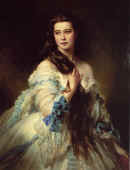 Dubbed the Painter of Princes, the most sought after Victorian haute portrait artist was Franz Xaver Winterhalter, (b.1805-d.1873). He painted on commission and in duplicate. Europe's courts and aristocratic homes were filled with his paintings.
Dubbed the Painter of Princes, the most sought after Victorian haute portrait artist was Franz Xaver Winterhalter, (b.1805-d.1873). He painted on commission and in duplicate. Europe's courts and aristocratic homes were filled with his paintings. Much of Winterhalter's work is on display in museums worldwide, including at the Metropolitan Museum of Art. His iconic style is recognizable. In essence, he captured his subjects' serene expressions and poses that speak of an era which idealized genteel ways.
The Meiji Constitution 1890
Also known as The Constitution of the Empire of Japan or the Imperial Constitution.
Japan’s first Diet also convened today, since it was a cavet of the constitution. Put into effect after the Meiji Renewal, this constitution provided a constitutional monarchy based on the Prussian model. Basically, the Emperor of Japan was ruler and exerted considerable political power, but he had to share that power with the elected diet.
This constitution lasted until the Japanese defeat at the end of World War II.
From Hirobumi Ito, Commentaries on the constitution of the empire of Japan,translated by Miyoji Ito (Tokyo: Igirisu-horitsu gakko, 22nd year of Meiji,1889)Hanover Historical Texts Project: http://history.hanover.edu/texts/1889con.html
http://en.wikipedia.org/wiki/Meiji_Constitution
http://afe.easia.columbia.edu/japan/japanworkbook/modernhist/meiji.html
http://concise.britannica.com/ebc/article-9371768/Meiji-Constitution
http://www.hku.hk/history/nakasendo/const889.htm
Tuesday, November 28, 2006
Hawaiian Independence Day 1843
http://www.hawaiian-roots.com/hawaiihistory.htm
http://www.hawaiianhistory.org/
http://www.hawaiihistory.com/index.cfm
http://en.wikipedia.org/wiki/Kingdom_of_Hawaii
http://www.thisweek.com/goodies/facts/history.html
Monday, November 27, 2006
Alfred Nobel Creates Prizes 1895
Rumor has it that an erroneous publication in 1888 of his obituary by a French newspaper, condemning his invention of dynamite, made him decide to leave a better legacy to the world. The obituary stated Le marchand de la mort est mort ‘The merchant of death is dead’; "Dr. Alfred Nobel, who became rich by finding ways to kill more people faster than ever before, died yesterday."
The amount set aside for the Nobel Prize foundation was 31 million kronor or $4,223,500
http://en.wikipedia.org/wiki/Alfred_Nobel
http://nobelprize.org/alfred_nobel/
http://www.britannica.com/nobel/micro/427_33.html
Friday, November 24, 2006
Victorian Medicine
Thursday, November 23, 2006
Franklin Pierce featured in the news today
A Day of Thanksgiving and Praise
By the President of the United States of America.
A Proclamation.
The year that is drawing towards its close, has been filled with the blessings of fruitful fields and healthful skies. To these bounties, which are so constantly enjoyed that we are prone to forget the source from which they come, others have been added, which are of so extraordinary a nature, that they cannot fail to penetrate and soften even the heart which is habitually insensible to the ever watchful providence of Almighty God. In the midst of a civil war of unequaled magnitude and severity, which has sometimes seemed to foreign States to invite and to provoke their aggression, peace has been preserved with all nations, order has been maintained, the laws have been respected and obeyed, and harmony has prevailed everywhere except in the theatre of military conflict; while that theatre has been greatly contracted by the advancing armies and navies of the Union. Needful diversions of wealth and of strength from the fields of peaceful industry to the national defense, have not arrested the plough, the shuttle or the ship; the axe has enlarged the borders of our settlements, and the mines, as well of iron and coal as of the precious metals, have yielded even more abundantly than heretofore. Population has steadily increased, notwithstanding the waste that has been made in the camp, the siege and the battle-field; and the country, rejoicing in the consiousness of augmented strength and vigor, is permitted to expect continuance of years with large increase of freedom. No human counsel hath devised nor hath any mortal hand worked out these great things. They are the gracious gifts of the Most High God, who, while dealing with us in anger for our sins, hath nevertheless remembered mercy. It has seemed to me fit and proper that they should be solemnly, reverently and gratefully acknowledged as with one heart and one voice by the whole American People. I do therefore invite my fellow citizens in every part of the United States, and also those who are at sea and those who are sojourning in foreign lands, to set apart and observe the last Thursday of November next, as a day of Thanksgiving and Praise to our beneficent Father who dwelleth in the Heavens. And I recommend to them that while offering up the ascriptions justly due to Him for such singular deliverances and blessings, they do also, with humble penitence for our national perverseness and disobedience, commend to His tender care all those who have become widows, orphans, mourners or sufferers in the lamentable civil strife in which we are unavoidably engaged, and fervently implore the interposition of the Almighty Hand to heal the wounds of the nation and to restore it as soon as may be consistent with the Divine purposes to the full enjoyment of peace, harmony, tranquillity and Union.
In testimony whereof, I have hereunto set my hand and caused the Seal of the United States to be affixed.
Done at the City of Washington, this Third day of October, in the year of our Lord one thousand eight hundred and sixty-three, and of the Independence of the Unites States the Eighty-eighth.
By the President: Abraham Lincoln
William H. Seward,
Secretary of State
http://showcase.netins.net/web/creative/lincoln/speeches/thanks.htm
Victorian Clipper Ship 1869
The Cutty Sark was destined for the China tea trade. However, she did not distinguish herself. In the most famous race, against Thermopylae in 1872, both ships left Shanghai on June 18, but two weeks later Cutty Sark lost her rudder after passing through the Sunda Strait, and arrived a week after Thermopylae, for a total passage of 122 days. Her legendary reputation is supported by the fact that her captain chose to continue this race with an improvised rudder rather than putting into port for a replacement. She still managed to be beaten by only one week.
Hart Crane's The Bridge immortalized Cutty Sark.
(http://www2.wwnorton.com/catalog/backlist/040225.htm)
http://en.wikipedia.org/wiki/Cutty_Sark
http://www.cuttysark.org.uk/
http://www.greenwich-guide.org.uk/cutty.htm
Wednesday, November 22, 2006
1864 Hood enters Tennessee
In a desperate attempt to draw Sherman out of Georgia, General John Bell Hood invaded Tennessee. It was a huge mistake.
The sad saga of the Army of Tennessee in 1864: In the spring, the army, commanded by Joseph Johnston, blocked Sherman's path to Atlanta from Chattanooga. During that summer, Sherman and Johnston fought a series of relatively small engagements as Sherman tried to flank the Rebel army. Johnston slowly retreated toward Atlanta, but kept his army intact.
Unfortunately for both the army and Georgia, Confederate President Jefferson Davis had seen enough territory lost to the Yankees, and in July 1864 replaced the defensive Johnston with the aggressive Hood. Hood made a series of attacks on Sherman outside of Atlanta that did nothing but diminish his own army's capabilities. After a one-month siege, Hood was forced to withdraw from Atlanta.
The invasion into Tennessee marked the start of a new campaign that was nothing but a disaster for the Confederates. Sherman took part of his force, cut loose from his supply lines, and began his March to the Sea. He sent the rest of the force under George Thomas back to Nashville to guard against Hood. Hood took the bait and charged toward Thomas in Franklin, Tennessee. It was a devastating defeat. But he didn't learn his lesson and continued on to attack Thomas at Nashville on December 15.
By the time Sherman made it to Savannah just before Christmas 1864, little remained of Hood's once-proud Army of Tennessee.
http://www.history.com/tdih.do?action=tdihArticleCategory&id=2395
http://www.brainyhistory.com/events/1864/july_22_1864_55910.html
http://www.curledup.com/breakcon.htm
Tuesday, November 21, 2006
Lord Melbourne Gave Fatherly Advice to the Young Queen Victoria
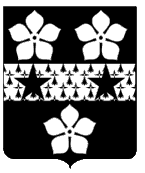
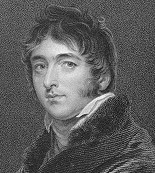 Queen Victoria sought out the advice, daily if possible, from William Lamb, the Second Viscount Melbourne, who was her real father figure. She kept a journal. Nightly, she’d inscribe his answers to her questions about life. A list of some of his sage advice is as follows:
Queen Victoria sought out the advice, daily if possible, from William Lamb, the Second Viscount Melbourne, who was her real father figure. She kept a journal. Nightly, she’d inscribe his answers to her questions about life. A list of some of his sage advice is as follows:· wives beaten by husbands are able to profit from the pity evoked
· mothers-in-law are not known to get along with daughters-in-law
· most marriages aren’t happy
· large dogs are dangerous as pets
· birds migrate by following the coastline
Eventually, Victoria’s role as monarch prohibited her from continuing correspondence with the then retired Prime Minister, for reasons of propriety.
http://en.wikipedia.org/wiki/William_Lamb%2C_2nd_Viscount_Melbourne
http://www.noelcollection.org/noel/Jerdan/lamb.html
Persons of Consequence: Queen Victoria and Her Circle by Louis Auchincloss ISBN #0394504275
Inventor of the Phonograph
Accidental invention. As with many things in life, Edison stumbled on one of his great inventions while working on a way to record telephone communication at his laboratory in Menlo Park, New Jersey. Because of this, he was dubbed "Wizard of Menlo Park."
http://www.history.com/tdih.do?action=tdihArticleCategory&id=5537
http://memory.loc.gov/ammem/edhtml/edcyldr.html
Sunday, November 19, 2006
Four Score and Seven Years Ago...

Most of us have heard those famous words, but I wonder how often anyone takes the time to reflect upon their meaning.
On November 2, 1863, many months after the battle of Gettysburg (July 1-3, 1863) had ended, Governor David Wills invited President Abraham Lincoln to make "a few appropriate remarks” at the consecration of a cemetery for the Union war dead.
Lincoln accepted the invitation, probably viewing the event as an appropriate time to honor the war dead, as well as reveal his evolving thinking about the war, not merely as a fight to save the Union but as an opportunity to establish freedom for all those under the law.
On November 19, 1863, in Gettysburg, Pennsylvania, Lincoln spoke the now-famous words. At the time, the President drew criticism because of the brevity of his comments. Yet those “few appropriate remarks” have gone on to be one of the most memorable speeches of all time:
Four score and seven years ago, our fathers brought forth upon this continent a new nation: conceived in liberty, and dedicated to the proposition that all men are created equal.
Now we are engaged in a great civil war. . .testing whether that nation, or any nation so conceived and so dedicated. . . can long endure. We are met on a great battlefield of that war.
We have come to dedicate a portion of that field as a final resting place for those who here gave their lives that that nation might live. It is altogether fitting and proper that we should do this.
But, in a larger sense, we cannot dedicate. . .we cannot consecrate. . . we cannot hallow this ground. The brave men, living and dead, who struggled here have consecrated it, far above our poor power to add or detract. The world will little note, nor long remember, what we say here, but it can never forget what they did here.
It is for us the living, rather, to be dedicated here to the unfinished work which they who fought here have thus far so nobly advanced. It is rather for us to be here dedicated to the great task remaining before us. . .that from these honored dead we take increased devotion to that cause for which they gave the last full measure of devotion. . . that we here highly resolve that these dead shall not have died in vain. . . that this nation, under God, shall have a new birth of freedom. . . and that government of the people. . .by the people. . .for the people. . . shall not perish from the earth.
Well said, Mr. President.
For more information on the Gettysburg Address or Abraham Lincoln, visit:
http://rmc.library.cornell.edu/gettysburg/
http://www.nps.gov/archive/gett/home.htm
http://americancivilwar.com/north/lincoln.html
http://sc94.ameslab.gov/TOUR/alincoln.html
Saturday, November 18, 2006
First Time Zones
Local time was based on "High Noon" in just about each town, and I can't even imagine the nightmare it was to travel from Boston to New York to Philadelphia and constantly resetting your watch. Worse than jetlag! But as railroads shrunk the time it took to get from town to town, this way of keeping time was a logistical nightmare. Railroad timetables in major cities listed dozens of different arrival and departure times. All for the same train and each linked to a different local time zone.
So the companies divided the continent into four time zones, zones that are very close to what is still used today. Most Americans and Canadians quickly embraced their new time zones, since railroads linked them with the rest of the world. However, the federal government was different. It wasn’t until 1918 that Congress officially adopted the railroad time zones and put them under the supervision of the Interstate Commerce Commission.
http://www.history.com/tdih.do?action=tdihArticleCategory&id=4341http://www.enchantedlearning.com/inventors/page/t/timezones.shtml
Friday, November 17, 2006
Suez Canal opens
French Empress Eugénie, wife of Napoleon III, attended the inauguration ceremony. It took 15 years to complete the 100 mile canal across the Isthmus of Suez.
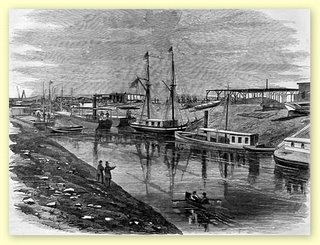 In 1856, the Suez Canal Company was formed and granted rights to operate the canal for 99 years after completion. (WWII changed that.) At first forced laborers used picks and shovels. Later, when the Europeans arrived to work it, so did the dredgers and steam shovels. This may have been a coincidence. Labor disputes and cholera interrupted the work, and the 1869 date was actually 4 years behind schedule.
In 1856, the Suez Canal Company was formed and granted rights to operate the canal for 99 years after completion. (WWII changed that.) At first forced laborers used picks and shovels. Later, when the Europeans arrived to work it, so did the dredgers and steam shovels. This may have been a coincidence. Labor disputes and cholera interrupted the work, and the 1869 date was actually 4 years behind schedule.
Ferdinand de Lesseps, its builder, would later failure at an attempt to build a canal across the Isthmus of Panama.
Today, an average of 50 ships navigate the canal daily, carrying more than 300 million tons of goods a year.
http://www.history.com/tdih.do?action=tdihArticleCategory&id=5530
http://ce.eng.usf.edu/pharos/wonders/Modern/suezcanal.html
http://www.touregypt.net/featurestories/suezcanal.htm
Thursday, November 16, 2006
Most Victorian Crosses Won in a Single Day 1857
Sir Colin Campbell easily crossed the nearly dry Charbagh Canal and advanced on the Secundrabagh, which housed most of the rebels. After its walls were breached by covering artillery fire, the 93rd Highlanders, part of the 53rd Regiment of Foot, the 4th Punjab Infantry, and various other detachments stormed it. It was a horrific defeat for the rebels. According to Campbell, some 2,000 rebels died. Later that day, Campbell's forces also stormed the Shah Najaf mosque, only a few hundred yards from the British defenders of the Chuttur Munzil.
http://en.wikipedia.org/wiki/Siege_of_Lucknow
http://www.defencejournal.com/2000/mar/lucknow.htm
http://theoldentimes.com/lucknow_1.html
http://www.army.mod.uk/lightinfantry/history_traditions/major_battles/lucknow_1857_1858.htm
Wednesday, November 15, 2006
Deposed - Brazil's Last Emperor 1889
Pedro left for Europe and died in exile 2 years later.
There's actually more to it than that, and a very interesting story with Portugal's crown prince, Don Pedro, declaring Brazil an independent country under his rule. But he was a lousy ruler, and Portugal was probably lucky he wasn't their leader. Pedro I abdicated in favor of his 5 year-old-son. Who, it turned out at age 15, didn't inherit his father's bad-ruler genes.
http://www.history.com/tdih.do?action=tdihArticleCategory&id=5525
http://www.if.ufrj.br/general/brazil.html
http://www.historicaltextarchive.com/sections.php?op=viewarticle&artid=529
http://gosouthamerica.about.com/od/brahistory/qt/IndependenceDay.htm
http://www.answers.com/topic/pedro-ii-of-brazilhttp://historicaltextarchive.com/sections.php?op=viewarticle&artid=427
Tuesday, November 14, 2006
Moby-Dick published 1851
http://www.history.com/tdih.do?action=tdihArticleCategory&id=4152
http://www.princeton.edu/~batke/moby/moby-1.html
http://www.online-literature.com/melville/mobydick/
Monday, November 13, 2006
Seattle Washington, 1851
http://en.wikipedia.org/wiki/Denny_Party
http://www.historylink.org/essays/output.cfm?file_id=5392
http://seattlepi.nwsource.com/local/46423_denny13.shtml
Friday, November 10, 2006
Railroads During the Civil War
Thursday, November 09, 2006
Jack the Ripper kills last known victim 1888
http://en.wikipedia.org/wiki/Jack_the_Ripper
http://www.casebook.org/
http://www.crimelibrary.com/serial_killers/notorious/ripper/index_1.html
http://www.met.police.uk/history/ripper.htm
Wednesday, November 08, 2006
Victorian Discoveries
He dubbed the ray ‘X’ because of the unknown nature of the ray. He won every German accolade, streets, towns, (probably babies) and honorary doctorates and memberships in learned German society. In 1901, he won the Nobel Prize in physics.
http://www.history.com/tdih.do?action=tdihVideoCategory&id=52083
http://nobelprize.org/nobel_prizes/physics/laureates/1901/rontgen-bio.html
http://www.britannica.com/nobel/micro/509_85.html
Tuesday, November 07, 2006
Canada's transcontinental railway completed 1885
Craigellachie, in the mountains of British Columbia, was witness to the last spike driven into Canada's first transcontinental railway. It took 5 years for the Canadian Pacific Railway to get the 4,600 kilometers of single track all connected. Several smaller lines were also conencted to the larger CPR, uniting the country as never before.
Believe it or not, it was completed 6 years ahead of schedule.
http://www.history.com/tdih.do?action=tdihArticleCategory&id=5503
http://www8.cpr.ca/cms/English/General+Public/Heritage/A+Brief+History.htm
http://www.answers.com/topic/national-transcontinental-railway
And for those in America, I hope everyone voted!
Monday, November 06, 2006
Congratulations, Mr. President...and Mr. President
In 1861, Jefferson Davis is elected the 1st president of the Confederate States of America
Both were natives of Kentucky. Lincoln was the first Republican elected with only 40% of the popular vote, but defeating 3 other candidates. Davis ran unopposed. Lincoln was a lawyer and a Whig representative to Congress before running for president in the heavily divided 1860 election. Davis attended West Point, served in the Black Hawk War of 1832, was a close advisor to then-General Zachary Taylor (former father-in-law) during the Mexican War, before becoming a senator and Secretary of War under President Franklin Pierce.
http://www.history.com/tdih.do?action=tdihArticleCategory&id=2378
http://www.history.com/tdih.do?action=tdihArticleCategory&id=5500
http://www.whitehouse.gov/history/presidents/al16.html
http://www.historyplace.com/lincoln/index.html
http://www.swcivilwar.com/davis.html
http://jeffersondavis.rice.edu/
Sunday, November 05, 2006
Victorian Fans Were Ever Popular
This month, many of Queen Victoria’s fans and those of her family and contemporaries will be on display at The Queen’s Gallery, Buckingham Palace. The collection can also be viewed online in their e-gallery. The article entitled Unfolding Pictures in Majesty Magazine, Vol 27 No 11 highlights some of the fans that will be on display in The Queen’s Gallery mid-month.
Empress Eugénie, wife-consort of Napoleon III of France, was from Granada, Spain where fans were used for everyday affaires and were known to always be in motion. Eugenie brought much of her rich Spanish heritage to the popular and dominant French court, including her love of fans. She was known for making statements with her fans, as were many of the ladies of her era, by matching the fans to ensembles or by wearing plain ensembles that made extravagant fans stand out.
Fans served many purposes. The rules dictated that fans remained closed while one was in the presence of a sovereign, so many fans displayed unique identifying embellishments along their sides. Monograms were popular as well as artwork of family and portraits of children of the fan’s owner. Symbols of rank were also appropriate to display on fans, or simply one-of-a-kind artwork. Prized and valuable fans were typically attached to a wrist to be dropped or retrieved, according to a lady’s purposes.
Due to their artistry, fans became a favorite collectible during the 19th Century. Even during church services, fans were noted to be constantly expressing their bearers emotions, especially in Spanish speaking countries and Colonies. Some regions designed their own signals around fan usage. In Puerto Rico, young ladies were known to flirt or otherwise indicate if they were or weren’t available for romance. The speed at which a fan passed across a lady's breasts was the clue. Other regions also utilized their own unique communications with fans.
Friday, November 03, 2006
Black Bart's last stagecoach robbery 1883
http://www.history.com/tdih.do?action=tdihArticleCategory&id=4326
http://www.blackbart.com/
http://www.sfmuseum.org/hist9/blackbart.html
Thursday, November 02, 2006
Time Zones 1868
New Zealand officially adopts a standard time to be observed nationally.
Standard time zone: UTC/GMT +12 hours
Daylight saving time: +1 hour
Current time zone offset: UTC/GMT +13 hours
Wednesday, November 01, 2006
Gold Standard 1893
http://www.u-s-history.com/pages/h762.html
http://www.u-s-history.com/pages/h792.html
http://www.history.com/tdih.do?action=tdihArticleCategory&id=6222
Tuesday, October 31, 2006
Congress admits Nevada as the 36th state 1864
Never let it be said that Congress doesn't know a gold mine when it sees one. Or in Nevada's case, the 1859 discovery of the incredibly large and rich silver deposits at Virginia City.
http://www.history.com/tdih.do?action=tdihArticleCategory&id=4323
http://www.answers.com/topic/nevada
http://www.nevadaweb.com/nevadaca/rocha-2.html
Monday, October 30, 2006
Gettysburg Ghost Stories
Second War of Schleswig (the Danish-Prussian War) 1864
http://en.wikipedia.org/wiki/Second_war_of_Schleswig
http://www.history.com/encyclopedia.do?articleId=221760
http://www.answers.com/topic/second-war-of-schleswighttp://www.germannotes.com/archive/article.php?products_id=423&osCsid=7ac0a040b48f5b8488909be37456fadc
Friday, October 27, 2006
Victorian Shopping - Macy’s opens 1858
http://www1.macys.com/store/about/history/index.jsp
http://www.history.com/tdih.do?action=tdihArticleCategory&id=6208
Thursday, October 26, 2006
Shoot-out at the OK Corral 1881
http://www.history.com/tdih.do?action=tdihVideoCategory&id=51977
http://www.sccs.swarthmore.edu/users/98/dylan/tomb/shootout.html
http://www.tombstone.250x.com/
Wednesday, October 25, 2006
Charge of the Light Brigade 1854
Poem: http://poetry.eserver.org/light-brigade.html
Movie: http://www.imdb.com/title/tt0027438/
http://www.history.com/tdih.do?action=tdihArticleCategory&id=5467
http://pinetreeweb.com/13th-balaclava2.htmhttp://news.bbc.co.uk/1/hi/magazine/3944699.stm
Tuesday, October 24, 2006
First Barrel Ride Down Niagara Falls 1901
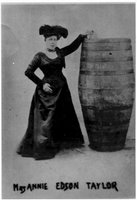
Annie Edson Taylor, 63, was the first to take the plunge. While not the first person over the falls (and who knows how many were tossed over them against their will) she was the first to do it in a barrel. Poor and seeking fame and fortune, the Civil War widow and 2 assistants strapped herself into a barrel 5 feet high and 3 feet around. Leather straps and cushions lined the barrel to protect her. However, her 15 minutes of fame lasted only about that and there was no fortune for Annie. She spent the rest of her life working as a street vendor in Niagara Falls, and died there in 1921.
http://www.history.com/tdih.do?action=tdihArticleCategory&displayDate=10/24&categoryId=leadstory
http://www.nfpl.library.on.ca/stuntupload/annie_taylor.html
http://travel.howstuffworks.com/niagara5.htm
Monday, October 23, 2006
NYSE seats up for sale: 1869
http://web.mit.edu/moser/www/nyse60105.pdf
http://www.history.com/tdih.do?action=tdihArticleCategory&id=6198
Sunday, October 22, 2006
Victorians Hosted State Balls and Informal Balls

Victorians were trendy. Their entertainments reflected their awareness of trends, and their societal need to keep apace.
Napoleon III ran his Imperial Court with a flare unseen for decades on the Continent. Off-the-Continent, the Imperial Courts in the Americas were following suit. In particular, because Napoleon III sponsored the Mexican Imperials of the Second Empire - the Emperor Maximilian and Empress Carlota - that court particularly complied with protocal.
Two types of grand balls were accounted for during the Victorian era; State Balls and a casual tradition that was dubbed "Empress' Mondays". Victorian era authors may find it useful to include either style of ball to suit their authorial machinations. They differed in some of the following manners:
State Balls
* were very grandiose
*sovereign hosts arrived by 9:30 p.m. as witnessed by a large audience of attendees
* held in ballrooms
* said hosts retired early for the night, by midnight
* balls often continued until 4 a.m.
* full orchestras played throughout the night
* all attendees wore ascribed court dress such as that worn by the lady-in-waiting displayed top right, Dona Sanchez-Navarre of the Mexican Imperial Court; essentially all women wore the same gown and all men wore the same court uniform or a military uniform with full decoration
* protocol was strict and ceremony was relied upon
* etiquette was strict
* public scrutiny was always of concern
* guest lists were a matter of politics
* visits of state dignitaries precedented state balls and determined when the ball was held
* displays of the latest technology were part of the entertainment, often part of the decor
* lighting at state balls was dimmed to enhance the display of attendee’s jewels
* physical appearances and beauty were irrelevant; the purpose of attending was political gain
Empress’s Mondays
* were less grandiose
*sovereign hosts started off the affaires around 10 p.m.
* held in Salons
* hosts remained at the ball throughout the night
* balls often ended by 2 a.m.
* partial orchestras played periodically, often hidden in the patios or gardens
* attendees wore trendy or traditional attire, often verging on a masquerade ball
* protocol was less strict and ceremony relaxed
* etiquette was relaxed
* balls were not available for public perusal
* guest lists were comprised of local Society, usually outside political arenas
* balls were warm and intimate, and held regularly on Monday nights
* décor was limited to the elegantly decorated Salons, and guests roamed the grounds
* lighting was normal
* guests might be invited simply for their charm or beauty
By Kristin-Marie
The World is Ending!
http://www.iath.virginia.edu/utc/christn/chmillhp.html
http://www.answers.com/topic/millerites
http://chi.gospelcom.net/DAILYF/2001/10/daily-10-22-2001.shtml
Saturday, October 21, 2006
Victorian Women in Medicine
The Lady with the Lamp
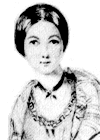
In 1854, Florence Nightingale and a staff of 38 women volunteer nurses, trained by Nightingale and including her aunt, Mai Smith, went to the Crimean. Sidney Herbert (Secretary at War 1845–1846 and 1852–1854) authorized the expidation. The nurses landed some 545 km across the Black Sea from Balaklava, where the main British camp was based.
http://www.florence-nightingale.co.uk/
http://en.wikipedia.org/wiki/Florence_Nightingale
http://www.agnesscott.edu/Lriddle/WOMEN/nitegale.htm
Friday, October 20, 2006
Bela Lugosi born 1882
http://www.history.com/tdih.do?action=tdihArticleCategory&id=3708
http://www.imdb.com/name/nm0000509/
http://www.auracom.com/tournier/webworld.htm
Thursday, October 19, 2006
Construction begins on the Sutro Tunnel in Virginia City, Nevada
In 1869, Prussian-born mining engineer, Adolph Sutro, began work on four-mile-long tunnel through the solid rock of the Comstock Lode. Miners sank shafts deeper and deeper into the rock in search of more silver and gold. The further into the Earth they mined, the more water they encountered. This had to be pumped to the surface at great expense.
Enter Adolph Sutro. With his nifty invention of horizontal drainage, mine water would drain through a tunnel, minus expensive pumps. Handily, these tunnels could also be used to move men and ore in and out, greatly reducing transportation costs.
Everyone agreed the tunnel would be a boon to the Comstock. But they worried that Sutro would use his tunnel to take control of the entire Lode, and progress was continually slowed because of that fear. It was only by securing European capital that Sutro able to complete the $5 million project in 1878.
Every bit as successful as promised, Sutro’s tunnel drained two million gallons of water per year, and greatly reduced transportation costs. Alas, by 1878, the richer sections of the Comstock Lode had been tapped out, and profitability declined. Sutro, however, sold his tunnel in 1879 at a extraordinary profit, and moved to San Francisco where he became one of the city's largest landowners and mayor from 1894 to 1896.
http://www.history.com/tdih.do?action=tdihArticleCategory&id=4311
http://www.nevadaobserver.com/The%20Sutro%20Tunnel%20(1912).htm
http://www.library.unr.edu/specoll/mss/nc7.html
http://www.knpb.org/productions/sutro/yellowjacket.asp
http://www.greenspun.com/bboard/q-and-a-fetch-msg.tcl?msg_id=005Gak
Wednesday, October 18, 2006
Tuberculosis, the Victorian Scourge
Why?
Well for one thing, it was the leading cause of death in the U.S. in the 19th century. From the beginning of the century thru 1870, it was the cause of 1 in 5 deaths, or 20%! Compare that with the "scourge" of the late 20th century, AIDS, which is does not even hit the top 5 causes of death in the U.S. http://library.thinkquest.org/16665/causes.htm
Like those infected with AIDS, though, victims of tuberculosis could live a very long time. It was a wasting disease (thus the 19th century term consumption), its sufferers not dying within days or weeks, but living with attacks and remissions that could last for years or decades. It allowed those infected to get married, have children, and pass the disease on to them. Families, therefore, could suffer from the infection for 2 or even 3 generations, passing it from parent/grandparent to children. In fact, for much of the century, the physicians thought the disease was hereditary, not contagious. They believed that families had a predisposition to the illness.
We now know, of course, that tuberculosis is contagious, transmitted through the air. Why didn't people understand that back then, when it was considered likely with other illnesses, such as colds and influenza? I suspect that's because first and foremost, having the TB bacteria doesn't necessarily mean you will develop the disease. In fact, only 5-10% of the people who have the bacteria ever develop the disease. http://www.who.int/mediacentre/factsheets/fs104/en/
Secondly, unlike diseases such as influenza or cholera, it can takes years to develop tuberculosis. You may have been exposed to it by a train passenger in 1850 and not develop symptoms for until 1855. Who could say, then, where you got the disease?http://www.concordma.com/magazine/winter03/tuberculosis.html
http://www.geocities.com/victorianlace16/diseases.html
The majority of this information came from Living in the Shadow of Death, Tuberculosis and the social Experience of Illness in American History by Sheila M. Rothman
America buys Alaska from Russians for US$7,200,000 1867
Larger in area than all but 18 of the world's nations, Alaska is derived from the Aleut Alyeska, meaning "great country", "mainland" or "great land". During the 18th century, Spaniards explored the coast and settled there – Cordova and Valdez.
U.S. Secretary of State William Seward (Seward’s Folly), urged the US to buy it, and while the transaction was completed on April 2, it wasn’t until October 18 that the hand over was completed. Or, if you go by the Julian calendar, Saturday, October 7, 1867 in Russia. Take your pick. That wasn’t the only problem Alaska had that day:
“Russia still used the Julian Calendar in 1867, and the world had not yet been divided into standard time zones; thus, there was no international date line, and the day began in the morning instead of starting at midnight. So, while the American day now ends with sunset in western Alaska, the Russian day then started with sunrise in "eastern" Alaska. Thus, Friday, October 6, 1867, the day before the physical transfer of ownership, was followed by Friday, October 18, 1867—which was Saturday, October 7, 1867 in Russia. The change in date was due to America bringing the Gregorian Calendar to Alaska, while the lack of change in day resulted from Alaska's shift from being the starting point of the Russian day to being the ending point of the American day.”
Get all that?
http://en.wikipedia.org/wiki/Alaska
http://www.akhistorycourse.org/
http://xroads.virginia.edu/~cap/BARTLETT/49state.html
Tuesday, October 17, 2006
A Rose by any Other Name...
And have you ever wished there was a publisher who actually wanted those stories that the others “aren’t looking for?” Maybe you have a story that’s a bit quirky, one that’s set in an era that isn’t selling well at this time, or maybe it features the old no-no of athletes or rock stars as heroes or heroines.
Meet The Wild Rose Press, a new and exciting small electronic and print publisher. Our titles span the sub-genre spectrum from sweet to sensually erotic and are available in all lengths including short story, novella, category and single title.
At The Wild Rose Press, where I am senior editor over the historical lines, we like to say “we help writers grow”. Not only are our editors willing to work with an author if they like the story or the characters, but we welcome those works that the bigger houses don’t want. Certainly that isn’t to say we publish works that are unpublishable because of poor writing skills or lack of an actual story, but we do enjoy finding new and different ideas. And we never hand out “form” rejections; each editor makes every effort to let the writer know what did and didn’t work for her. Most of us even take the time to include helpful suggestions in our rejection letters. Best of all, we have an entire “greenhouse” on our site full of articles on the nuts and bolts of writing to help writers at all levels of their career, from the beginner to the polished professional.
Each month offers new articles, interviews with authors and editors and lots and lots of new releases. I hope you’ll stop by our garden at www.thewildrosepress.com and visit us soon!
The Open Championship was first played on October 17, 1860 at Prestwick Golf Club
It was only in 1863 that a purse was awarded - £10 or about $50 at the time. However, the winner didn’t even get to keep the money! It was shared between the second, third, and fourth placed professionals. The Champ got to keep the belt for a year. In 1864, Old Tom Morris won the first Champion's cash prize of £6 (today it’s about $11). Today? £720,000 or $1,335,753.82.
http://www.opengolf.com/history/timeline.sps
http://www.opengolf.com/history/past_opens.sps?PartNo=1
Monday, October 16, 2006
First residential college for women in England est. 1869.
http://www.girton.cam.ac.uk/about/
Sunday, October 15, 2006
Chiricahua Apache leader Victorio is killed Tres Castillos Mountains south of El Paso, Texas 1880
Farming nearly impossible, and the conditions were deplorable. So Victorio decided this new reservation was unacceptable and moved his followers to more pleasant grounds at Ojo Caliente (Warm Springs). Unfortunately, this made him once again an outlaw in the eyes of the U. S.
In 1880, a combined force of U.S. and Mexican troops finally succeeded in tracking him down, surrounding them in the Tres Castillos Mountains. The Mexican soldiers sent the Americans away, and proceeded to kill all but 17 of the trapped Apaches. The exact manner of Victorio's death remains unclear. Some claimed an Indian scout employed by the Mexican army killed him. According to the Apache, Victorio took his own life rather than surrender to the hated Mexicans. Regardless, Victorio's death made him a martyr to the Apache people and strengthened the resolve of other warriors to continue the fight. The last of the great Apache warriors, Geronimo, would not surrender until 1886.
Victorio's sister was the famous woman warrior Lozen, Dexterous Horse Thief.
The character of Sierra Charriba, in Sam Peckinpah's film Major Dundee (1965), played by Michael Pate, was based off of Victorio.
http://www.greatdreams.com/apache/lozen.htm
http://www.history.com/tdih.do?action=tdihArticleCategory&id=4307
http://www.meyna.com/lozen.html
http://www.emayzine.com/lectures/APACHE.html
http://columbia.thefreedictionary.com/Apache
http://en.wikipedia.org/wiki/Victorio
Friday, October 06, 2006
Civil War Nurses
Monday, September 25, 2006
Victorian Nudes, Drawing Fine Lines at Fig Leaves
 The Victorian era witnessed a political push for indecency laws.
The Victorian era witnessed a political push for indecency laws.On any given day in any given city in nearly every neighborhood, foot traffic and passersby would be compelled to overlook the shockingly common sight of partially clad prostitutes and lower-class mistresses seeing Gentlemen into their gilded coaches at curbside.
As a side effect of the rise in Industry and the increase in technology, old and new artistic mediums were being utilized for increasingly visible pornography, shocking polite sensibilities.
Legislation began to be passed during the 19th Century to regulate Centuries-old traditions of pornography and nudity-in-public. Queen Victoria’s social influence in such matters belied the fact that her political opinions were being poppy-cocked in the Houses of Lords and Commons, alike. It came into fashion to adopt her moralistic stances as well as her embellished and prudish fashions, nostalgic décor, and gracious entertainments.
Hotly contested terms were applied to nudes and displays of nudity. The 19th Century revival in interest in the Renaissance era brought to the forefront historic painted nude portraits typical of royal and courtly ladies that were considered the equivalent of a modern family portrait during the Renaissance. Society during Victoria’s reign, however, required moralistic lines to be redrawn. Determinations were made as to whether new nudes or displays of nudity were to be considered classical, or not.
As Victorian-era artistic mediums evolved, photography of boudoir ladies, in particular, became increasingly available albeit driven underground. Any number of named and undisclosed models graced many a Victorian photographer’s portfolio for posterity to view. Art galleries of today are still known to display art shows from such Victorian photographers.
Acceptable nudity in artwork during the Victorian Era included a central attraction at the Great Exhibit -- the First World’s Faire -- of 1851. A nude sculpture by American artist Hiram Powers entitled Greek Slave [displayed top right], was considered acceptable for family viewing. Since the sculpted figure had a hand strategically draped, it was reviewed on the levels of a Sistine Chapel Garden-of-Eden occupant. The statue is housed at the Corcoran Gallery in Washington, D.C.
Polite Societies separated themselves from the undereducated masses by defining pornography, as well as determining new additions to the realms of Classical Art. Ultimately, the powerful Elite Minority triumphed, shutting out displays of public nudity and pornography.
No longer tolerated were previously typical public entertainments such as troupes of bare-breasted liveried female equestrians riding through crowded Central Parks while picnickers and strolling families gaped.
Not all municipalities passed the same laws at the same time regarding pornography and public nudity, nor cared to do so. In some parts of America, all one had to do was ride over the county lines to indulge.
By Kristin-Marie
Saturday, September 23, 2006
Period Quotes
"Ladies may walk unattended in the streets, being careful to pass on as becomes their station-neither with a hurried pace, nor yet affecting to move slowly. Shop-windows, in New York especially, afford great attractions; but it is by no means desirable to be seen standing before them, and most assuredly not alone. Be careful never to look back, nor to observe too narrowly the dresses of such ladies as may pass you. Should any one venture to address you, take no heed, seem not to hear, but hasten your steps. Be careful to reach home in good time. Let nothing ever induce you to be out after dusk, or when the lamps are lighted. Nothing but unavoidable necessity can sanction such acts of impropriety." Ladies, we've come a long way. Source: The Citizens' Companion; The Voice of Civilian Reenacting; Special Edition - August, 2006 pp. 29, 35 & 61
Tuesday, September 19, 2006
Heraldry, Fashionably Revived if Under-regulated
 An interest in classical heraldic elements was revived during the Victorian Era, hand-in-hand with the revival of Elizabethan and Renaissance Eras and nostalgia for pageantry.
An interest in classical heraldic elements was revived during the Victorian Era, hand-in-hand with the revival of Elizabethan and Renaissance Eras and nostalgia for pageantry.Most heraldry designed in the Victorian era was intentionally presumptuous. It crowded as many illustrious affectations into as small a space as possible. The result was beautiful and increasingly detailed heraldic artwork, sometimes used for show and sometimes just for contracts.
The historic Rothschild coat-of-arms displayed at right is typical of the times. The Victorian-ilk heraldry bears great resemblance to the re-popularized and ostentatious Renaissance styles.
Copper-plate engravings of armorial bookplates - available by custom order - were quite in demand with the General Public and sometimes commanded royal prices.
In general, armorial shields could be spotted on the sides of coaches, or worked into stained glass designs, or even displayed or disguised in Victorian architecture. University fraternities, such as Psi Upsilon, were going to great lengths to define and register their heraldic coats-of-arms.
A friendly web page with articles and resources is at The Heraldry Society www.theheraldrysociety.com. Other good reference sources exist with cultural historical groups, such as The Hispanic Society of America which often displays armorial textiles.
Debates arose, officially and unofficially, during the Victorian Era over whether a true 'gentleman' carried a coat-of-arms, or not, and about whether he could be considered a true gentleman if he didn't. Definitive answers were unavailable, as heraldry even to this day is largely under-regulated.
Attempts to redefine and consequently regulate popular usage of heraldry were made by barrister Arthur Charles Fox-Davies. His tome, The Art of Heraldry – An Encyclopedia of Armory, [0 906223 34 2] attested to his status as an expert on heraldry during Victorian times. His angle, though, was to disprove most usage of heraldry by any but certain registered armorial families in English and Welsh domain. (His studies didn't cover other countries or groups, for the most part.)
Civic heraldry designed during the Victorian Era remained true to popular sentiments with aggrandized artistry, making for fascinating displays intended to hold audiences enrapt.
The topic was a hotbed, and as a result, many heraldic artists decided to remain anonymous. Because heraldry was mostly unregulated, bestiaries listing definitions of the elements were closely horded like State Secrets. To this day, many countries and their armigers don't share bestiaries with the public.
Kristin-Marie
Monday, September 18, 2006
Robber baron causes panic 1873
The failure of the Philadelphia investment house of Jay Cooke & Co., who played a large role in financing the Union war effort by marketing federal bonds to farmers and workers, began when he decided to invest in just one more railroad. Between 1865-1873, Cooke's firm financed 35,000 miles of new railroads track.
The Union Pacific was a success. The Northern Pacific was not.
Railroads overbuilt, setting the stage for disastrous competition for freight traffic. Investors speculated heavily in railroad securities, and in 1873, it all crashed.
Cooke's failure drove panicked banks to demand payment of loans. Investors rushed to sell stocks in order to protect their capital.
“As stocks on the New York exchanges sunk lower, borrowers had no money with
which to pay their debts. Businessmen, many of whom had borrowed money to
expand their operations during boom times, released workers.”
It’s got to be difficult to be single handedly responsible for such a financial depression. Cooke was in bankruptcy, involved in Canadian corruption scandals, caused Prime Minister Sir John A. Macdonald to lose his office in the 1873 election, and yet still managed to turn everything around.
By 1880 he’d met all his obligations, invested in an Utah silver mine, and was wealthy once more. Ha. Must be nice. Forced to give up his Ogontz, PA estate in bankruptcy, he repurchased it and converted it into a school for girls. Actually, it seemed he really was a nice guy.
http://www.history.com/tdih.do?action=tdihArticleCategory&id=6101
http://dig.lib.niu.edu/gildedage/narr3.html
http://www.u-s-history.com/pages/h213.html
http://www.thehistorybox.com/ny_city/panics/panics_article9a.htm
http://en.wikipedia.org/wiki/Jay_Cooke
Sunday, September 17, 2006
Battle of Yalu River (1894)
A Japanese fleet under Admiral Sukeyuki Ito was attempting to disrupt the landing of Chinese troops protected by a fleet under Admiral Ting Ju ch'ang. It’s considered a significant beginning for later battles, the so-called dreadnought technology.
"On 16 September the Japanese Navy, having carried out a landing operation at
Chinnampo, was returning to sea. Admiral Ito had with him a powerful force
comprising ten cruisers, a gunboat, an armed merchantman and a flotilla of
torpedo boats. Ito's flagship, the 4,277-ton Matsushima, mounted one 12.5-inch
and eleven 4.7-inch guns, as did her sister ships Itsukushima and Hashidate. The
Fuso and Takachiho carried two 10.2-inch and six 5.9-inch, the 2,200-ton Hiei
one 10.2-inch and two 5.9-inch and the 2,450-ton Chiyoda ten 4.7-inch guns.
Togo's Flying Squadron, the Naniwa, Yoshino, and Akitsushima, were also in
company."
http://www.russojapanesewar.com/yalu1894.html
http://www.bookrags.com/wiki/Battle_of_Yalu_River_(1894)
Saturday, September 16, 2006
Claim your land now! (Before all the good parts are taken.)
With one gunshot (that was probably heard by only half the people present) it began. Pioneers hungry for land raved on horseback and in carriages to stake their claims. Fighting broke out, but not too much was done – or could be done – about it.
“By 1885, a diverse mixture of Native American tribes had been pushed onto reservations in eastern Oklahoma and promised that the land would be theirs "as long as the grass grows and the water runs." Yet even this seemingly marginal land did not long escape the attention of land-hungry Americans. By the late nineteenth century, farmers had developed new methods that suddenly made the formerly reviled Plains hugely valuable. Pressure steadily increased to open the Indian lands to settlement, and in 1889, President Benjamin Harrison succumbed and threw open large areas of unoccupied Indian lands to white settlement. The giant Cherokee Strip rush was only the largest of a series of massive "land runs" that began in the 1890s, with thousands of immigrants stampeding into Oklahoma Territory and establishing towns like Norman and Oklahoma City almost overnight.”
http://www.history.com/tdih.do?action=tdihArticleCategory&id=4276
http://www.ok.gov/osfdocs/stinfo2.html
http://www.state.ok.us/?c=8
http://www.rosecity.net/tears/
http://www.pbs.org/wgbh/aia/part4/4h1567.html







